by Ed Challinor • May 1, 2020
Branding in Dentistry: A Data-Driven Paid Search Case Study
Just a few years ago, if you asked Google “how to buy branding ads”, they would recommend the display network. They would explain view throughs and indirect branding metrics that are by their definition, hard to measure.
If you Google “branding awareness with google” in 2020, you’ll get results about YouTube, still plenty of info about Display and lots on ‘how to measure’.
However, back in 2014, there was a branding study published by Google that has been largely forgotten. It was Larry Kim of Wordstream who helped me find it.
The link to this Google ‘metastudy’ has since moved and all that remains is the following infographic and description.
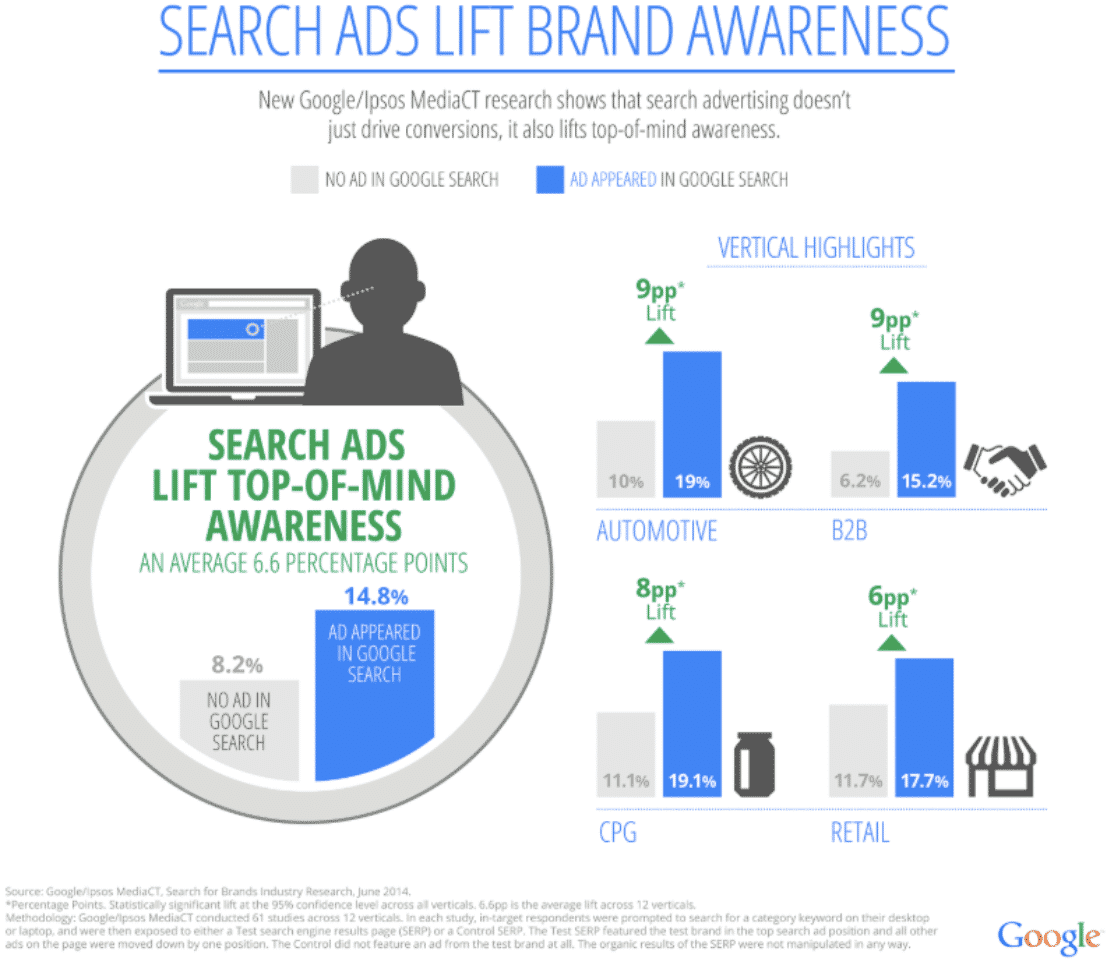
I’m no conspiracy theorist, but maybe the Google geeks realized they were really onto something here and have since ‘focused elsewhere’ to maintain a conversion-based use for top ads and a branding use for YouTube and Display. This would certainly align with their revenue strategy.
Here’s the TL:DR,
- 6.6% was the average lift, but some vertical-level results were impressively higher.
- In CPG, top-of-mind awareness was 11.1%, and search ads lift top-of-mind awareness by an average of 8-19.1%.
- In auto, there was an average lift of 9%.
The description goes:
“What’s behind these big increases? In part, simply this: search ads reach people who are already in a highly receptive mindset. After all, they are actively searching for topics related to your business, product or service. If your brand appears front and center in that moment, as they search, there’s a strong likelihood they’ll remember you.
Or to say it more simply: search ads can help build brand awareness.”
– Google 2014 (emphasis added)
So this got me thinking…
It all started with a walk to work one sunny morning and a search on my mobile phone. It was a discovery that had a profound effect on me. I was so excited I requisitioned 8 mobile phones, ran into the middle of the park and started frenetically Googling non-branded terms.
So what did I find? What were the specific problems I’d solved with this realization?
Well, let’s just say that it changed how we approach branded pay-per-click advertising here at Smileworks. The results have been impressive, to say the least, so let’s take a look at this approach, why it works and what the results have been for our dental practice.
A Bit About Our Business
Before we get started, though, I wanted to take a moment to give you a little context for our dental practice.
Smileworks is the dominant dentist in Liverpool, a city of 500,000 people. Liverpool is a hotly-competitive marketplace for orthodontics and terms like “six-month smiles” and “Invisalign®” are pulling clickthrough rates of between £5-10, and there are over 30 dental practices in the area.
80% of traffic arrives at Smileworks via mobile devices.
Our treatments range from inexpensive teeth whitening treatments at £199 to dental implants that might cost upwards of £20,000.
We spend about £15,000 a month on marketing (including advertising) and gross 1.6M top-line revenue with predicted revenue in 2019 of 2.1M. Our marketing is efficient and growing our practice over 50% YOY.
As you can see, we’re in a pretty good place as a dental practice, which is why branding is such an important part of our overall strategy. As a result, the approach we’re going to discuss here was perfect for our business, but it may not work exactly the same for dental practices in different situations.
Branding Your Dental Practice with Mobile Paid Search
Throughout the rest of this article, we’re going to be talking about a fairly novel idea: how do you use Google paid search ads to brand your business on mobile?
In a nutshell, you need three things to make this strategy work:
- A Google ad optimized for first position.
- A Google ad optimized for first position on mobile.
- A Google ad optimized for first position on mobile with relevant and engaging brand-focused copy.
We’ve used this strategy to great success here at Smileworks.
In our experience, we’ve seen a dramatic uplift on various metrics from utilizing position one on the mobile not for conversion purposes but as a branding device to establish a differentiated presence in the local market that attracts and retains customers.
How? To answer that question, let’s take a hard look at mobile search, its challenges and how you can use branded paid search ads to overcome those challenges.
Organic CTR is Decreasing on Mobile
If you recall, 80% of Smileworks’ traffic comes from mobile. That fact is what triggered this whole test and discovery.
After all, let’s be honest, if you don’t rank 1st on mobile, you may as well be on the second page.
This isn’t news, though. Just take a look at this study from SEO Clarity.
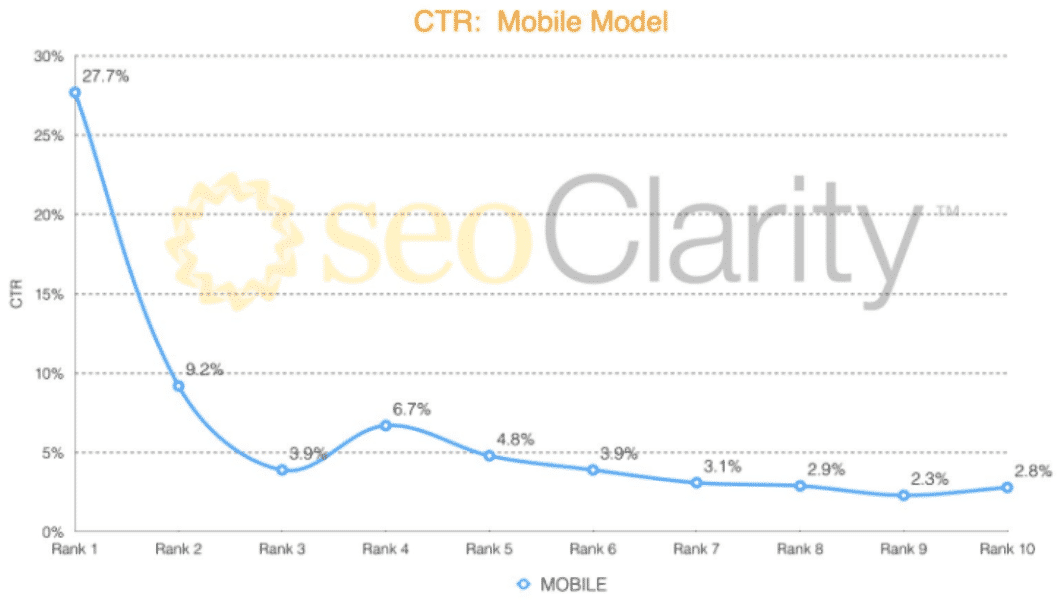
And this is how things were back in 2014. The mobile SERP landscape has changed unrecognizably in the years since this report, with total clicks decreasing sharply and the position one impression share crashing as each quarter rolls on.
Why Have Mobile Clicks Been Diminishing?
So what’s the issue here? Well, it’s the same thing we’ve seen happen to the desktop results pages–the zero-click results page and other assorted SERP features.
Also Google Ads affects clickthrough rates(but not by half as much as you probably think). There is a myth that Google Ads ‘steal clicks’ from organic, but this is really not the case at all.
There are now 2 out of 3 searches that don’t end up in a click at all. But luckily—at least, where branding is concerned—you don’t necessarily need clicks for success. It’s all about brand messaging.
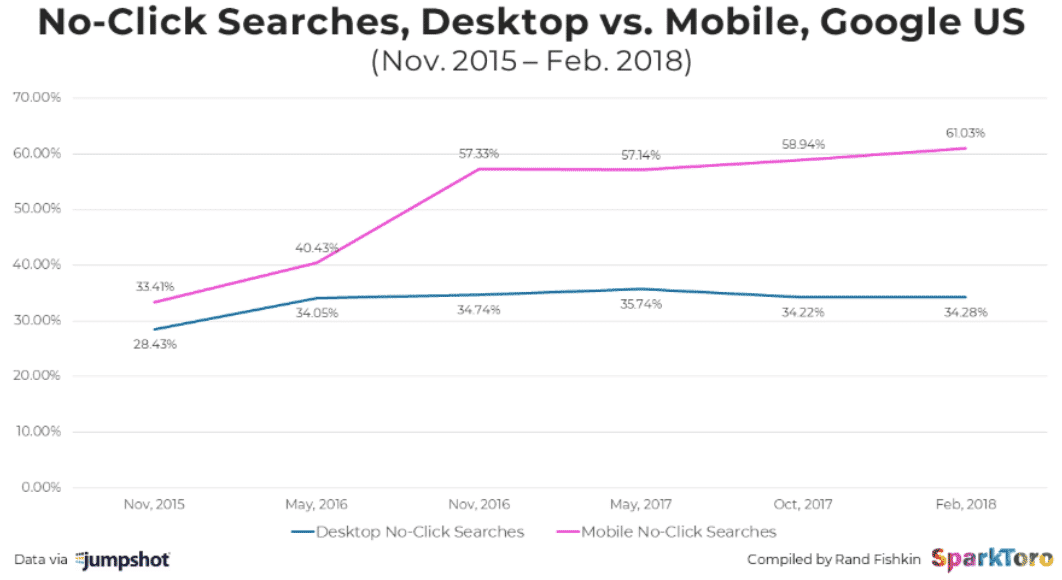
Here’s the state of SERP features from SEM Rush in March 2019.
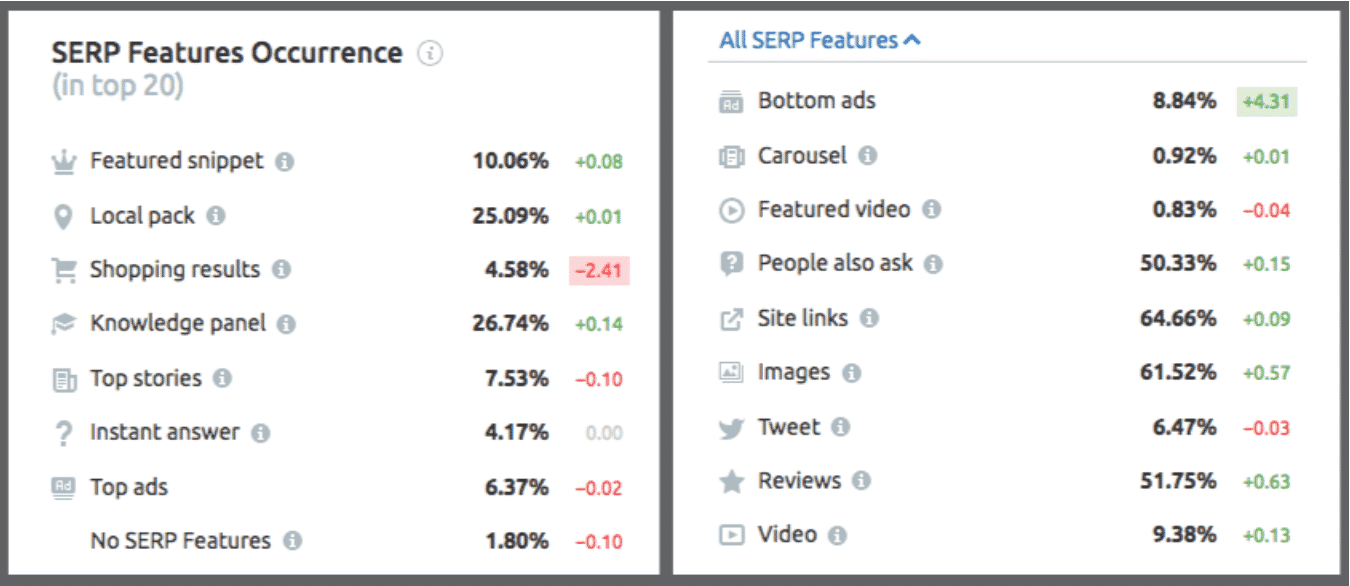
So how is the mobile organic CTR looking five years on since the SEO Clarity study?
Different people say different things, but according to the position has diminished by 32% with the organic CTR for position one on the mobile in 2019 sitting at just 21%.
Number one just ain’t what it used to be – but again, this isn’t news.
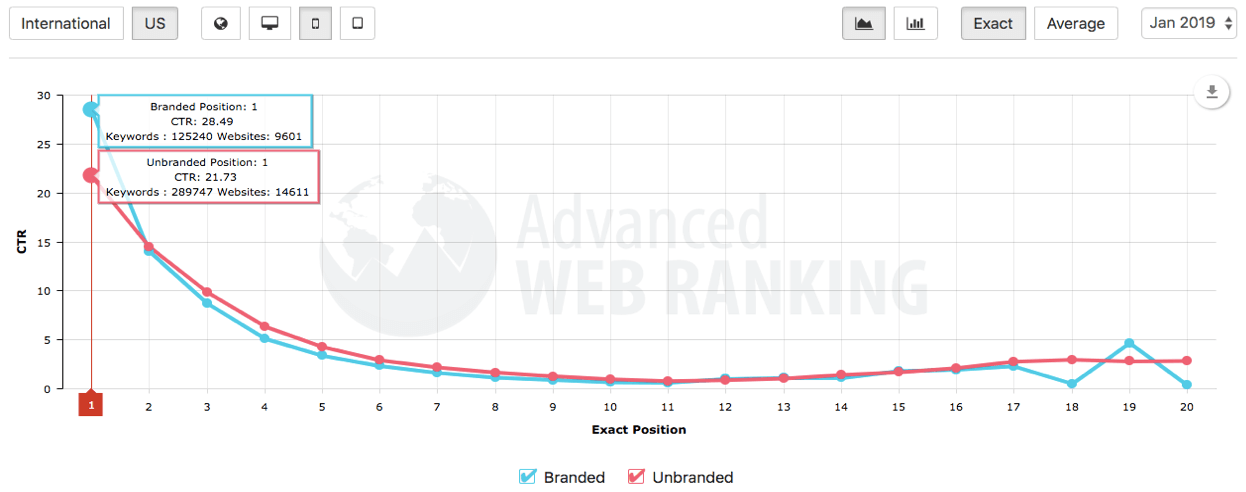
So what about the ads?
Google Ads CTR and Conversion Rate
This is more complicated and there’s plenty of conflicting research about conversions and CTR for certain ad positions. Here’s one of the best studies I could find.
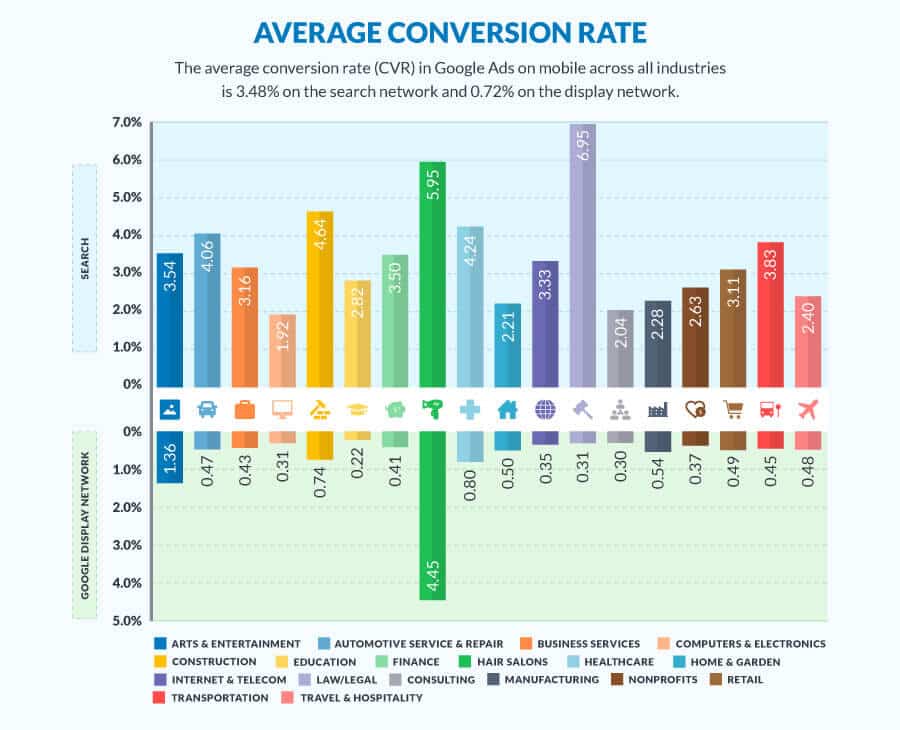
And here’s an analysis of the different ad types and their relative performance for CTR rather than conversion rate (which is highly dependent on your landing page and the status of your brand in the minds of the searchers).
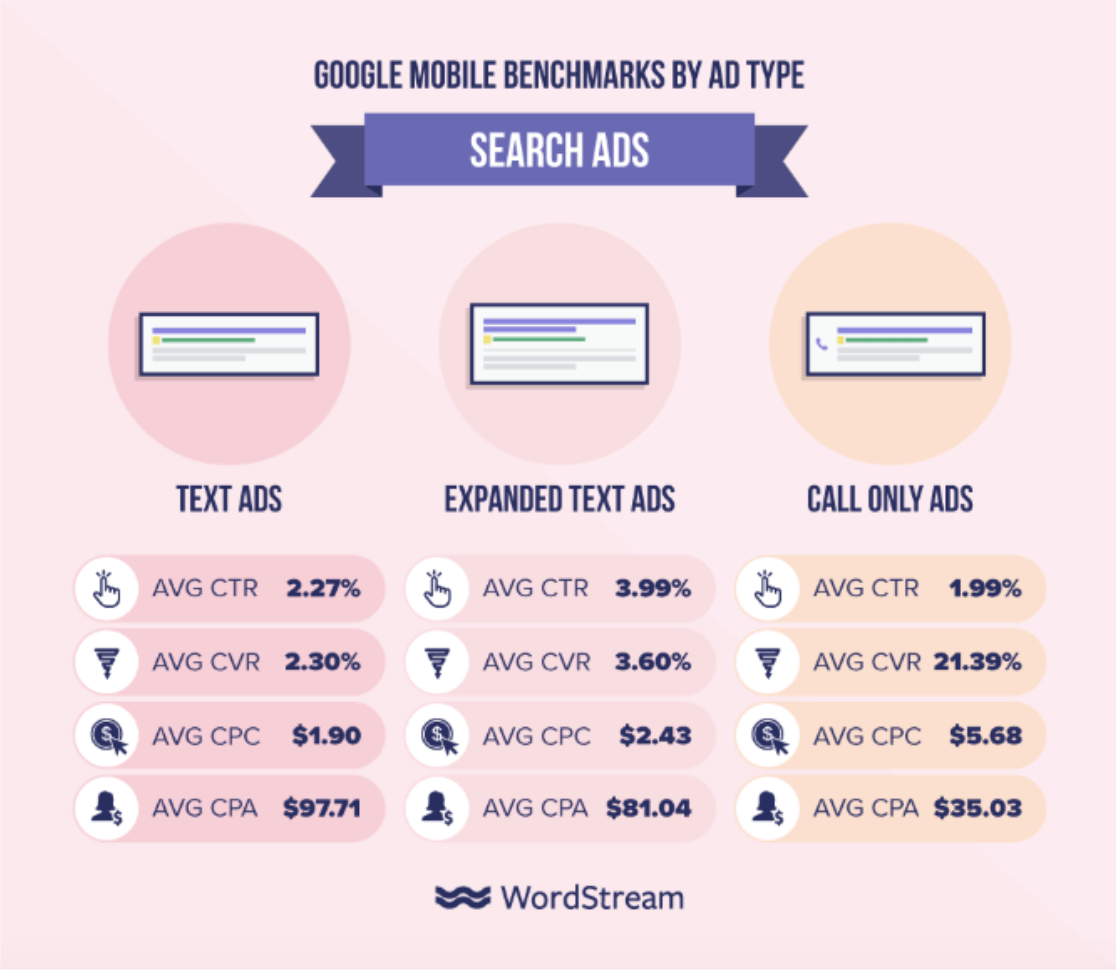
So expanded text ads (the ones I want to talk to you about) are getting a 3.99% average CTR, a conversion rate of 3.60% with finally a CPC of $2.43. Notice no data on site links or extensions as these are new(ish).
Incidentally, our results are many times better than these averages and I’m sure that’s partly down to the skills of my agency, Disruptive, but have also increased dramatically since we employed the branding method I’m going to discuss below.
The Eureka Moment
So, back to my walk into work that fateful sunny day. I was thinking about all the problems above that I’ve been grappling with for years.
SERPs are getting crowded and CTRs and conversion rates (and profits) are diminishing. It seems Alphabet is getting rich and we’re all suffering for it. And what’s the worst part? It’s not our competitors eroding the metrics, it’s Google! So we’re helpless to act.
So, I turned my mind to away from conversions for a moment and onto the subject of branding and mass marketing. How I can reach the largest possible market for my dental services? I want a bigger slice of the pie.
I think about all those folks who don’t see our ads. I think often “how can I reach those people?” With mass media or branding campaigns on the radio or TV. Maybe a billboard? Not likely.
I think about mass marketing because one of the most common things patients say to us at Smileworks is “I wish I’d found out about you sooner”.
I consider these elusive search volumes:
- 1,600 users a month
- 3,800 users a month
- 34,000 users a month
The simple fact is most of these volumes want a beautiful smile and everyone gets toothache, so I figured that mass marketing would be appropriate for dentistry.
So, while I was walking into work Googling all our keywords (a hobby of any SEO aficionado), something caught my eye.
I googled ‘Invisalign® Liverpool’—one of our highest ROI keywords—and expected to see Smileworks occupying the number one position in the mobile SERP. Especially since I was pretty close to the practice so Venice and Pigeon local were heavily favoring me for position one.
My various SEO tools tell me we’re in position one on the mobile for that term so that’s what I should be seeing, right?
Wrong.
What I saw was a Google ad. The screen took a second or two to load and the first paint was a giant Google ad with all the site links, expanded text and other fancy trimmings.
But what really excited me was that this ad filled the entire screen and seemed to hang there for perhaps 500 milliseconds while the rest of the SERP loaded.
It looked something like this:
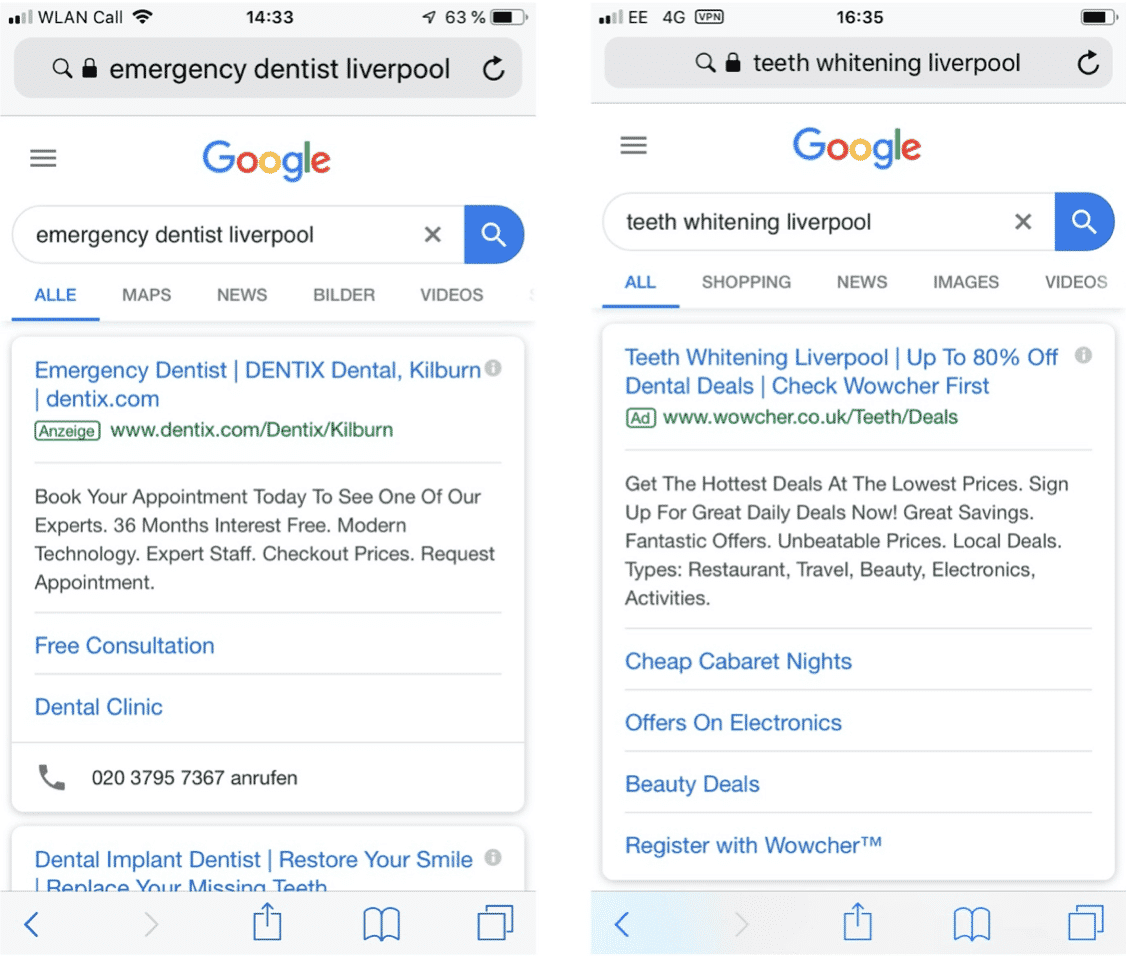
I read the ad and scrolled past it quickly looking for the number one position. And I never read ads. I’m an advertiser, which makes me practically ad-blind outside of researching projects, but there was literally nothing else to read!
The Solution
This was when it dawned on me. To reach my mass market, I just need to occupy that number one spot and occupy the entire first paint on the mobile.
I thought, This is my billboard! This is my front page magazine ad and this is my local radio spot. All 1,600 people, all 36,000 people will see my ad if I can get into that position permanently.
I realized this was a personalized billboard ad – showing on everyone’s phone covering their entire screen and dominating the first paint.
Not only that, these folks are in this Zen place of heightened awareness. Like some beautiful love-child of a ZMOT and a micro-moment!
Now, I know what you’re thinking, Why are you getting so excited? I know this already.
Although this may not seem like a big deal to you, the research—and what I see when I Google around—tells me people are approaching this wonderful opportunity in completely the wrong way.
They are wasting it.
They are also not distinguishing between the mobile and the desktop. If they were, there would be studies. But I don’t see studies. Do you?
The literature stops dead at conversion rates for top ads—it doesn’t cover this extra magical ability to be seen by 100% of the eligible searchers—let alone discuss the icing on the cake which is the specific messaging you must employ to make your “mobile billboard” resonate with the mass market.
Fact: There is no way a user can ignore the first position Google ad on mobile. Even if they are ‘ad blind’.
What No One Seems to Understand About Position 1
An ad that no one can ignore because it dominates their entire screen…this is the very definition Google coined back in 2014—on steroids.
“If your brand appears front and center in that moment, as they search, there’s a strong likelihood they’ll remember you.”
Most of the CTR studies (and there are tons) are examined through the lens of search. So we all understand that being number one is important. There are even plenty of research projects about Google Ads stating the importance of being in the top ads or on page one. But these relate to conversions and not brand messaging—including the 2014 study above.
What’s missing are studies about being first in the ads on the mobile. This confuses me because it’s clearly pretty important if you look at the results we’ve seen with this approach in our own practice.
The recent changes in the Google SERP have been manifold, but one thing remains. The Google Ads position one (for commercial terms) is ALWAYS the first thing you see.
- Before the maps
- Before organic position one.
- Before those dumb questions that you can expand forever and take up loads of space
- Before everything.
So my thesis is not that being first on the mobile is important—it’s that the first paint on mobile is everything.
What would an eye-tracking Heatmap look like for a mobile SERP triggering a Google top ad?
Maybe something like this?
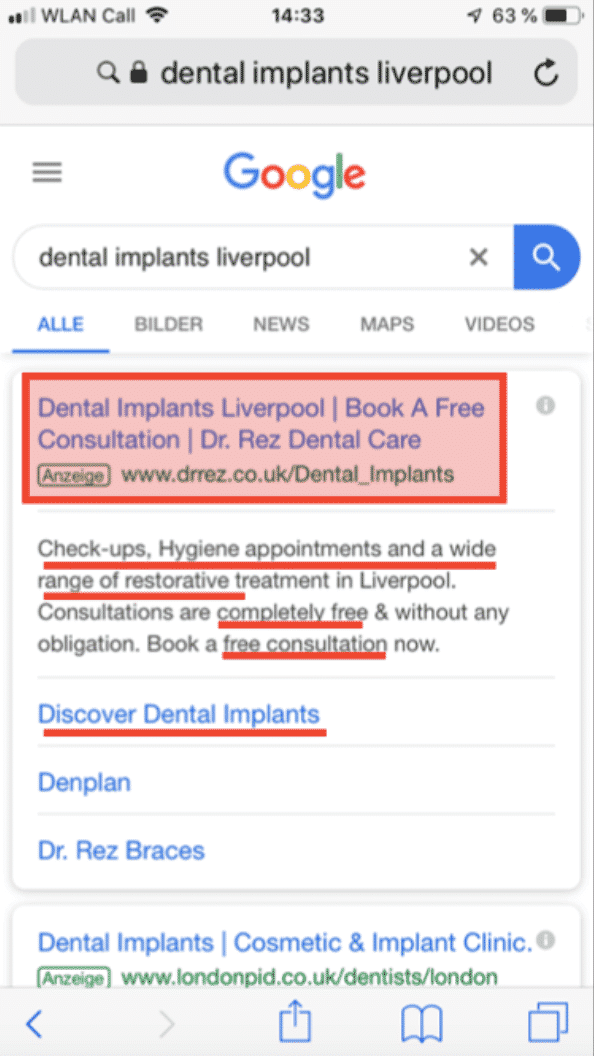
So let’s pretend this is where the patient is looking. There is literally no way you can lose. To ‘un-see’ this ad you don’t glance away, you need to scroll down. And scrolling down takes time. Enough time that—if the copy is good—the ad will stick because the viewer is in a heightened sense of awareness of what they want to buy.
It’s this act of scrolling (and the slight stickiness of the top ad) that makes all the difference.
In our view, this is the only way to retain a high enough eligible impression rate for your brand and is a much better alternative to traditional mass marketing on billboards, in the paper and even on the display net.
Real Results
So, how does this all work out in real life? Well, our methods yielded the following quantitive results:
- A 43% increase in patients to our practice over a 6 month period. This means we acquire on average 7 new patients a day for high-value treatments. By comparison, the average (for any treatment) in the US is 2 new patients a week.
- A 82.68% higher clickthrough rate compared to the industry average for health.
- A 22% increase in direct visits to the site.
- A 22% increase in organic CTR (for page one rankings only) across 479 high profit or volume keywords. This led to an extra 1,480 users a month from organic search.
- 21 extra position 1-3 keywords (this is difficult to pin down since we do lots of SEO, but I adjusted it to reflect an estimate based on previous performance and Google updates).
Our methods yielded the following qualitative results:
- An aggressive competitive pressure in the local market demonstrated by reduced organic and ad positions of our main competitors and an overwhelming impression share with 94% of our ads showing in position one on the mobile.
- A significant increase in market share organically and in Google Ads—modelled from patient numbers, search volumes, revenue increase and Google data.
- And most importantly, an increase in ROI of over 800%.
The Importance of Brand-Focused Copy
To make this sort of tactic work, though, your ad copy has to be on point. After all, many users may not actually click on your ad, so this is the only chance you have to win them over.
However, when I Google around, these are the sorts of ads I often see in position one:
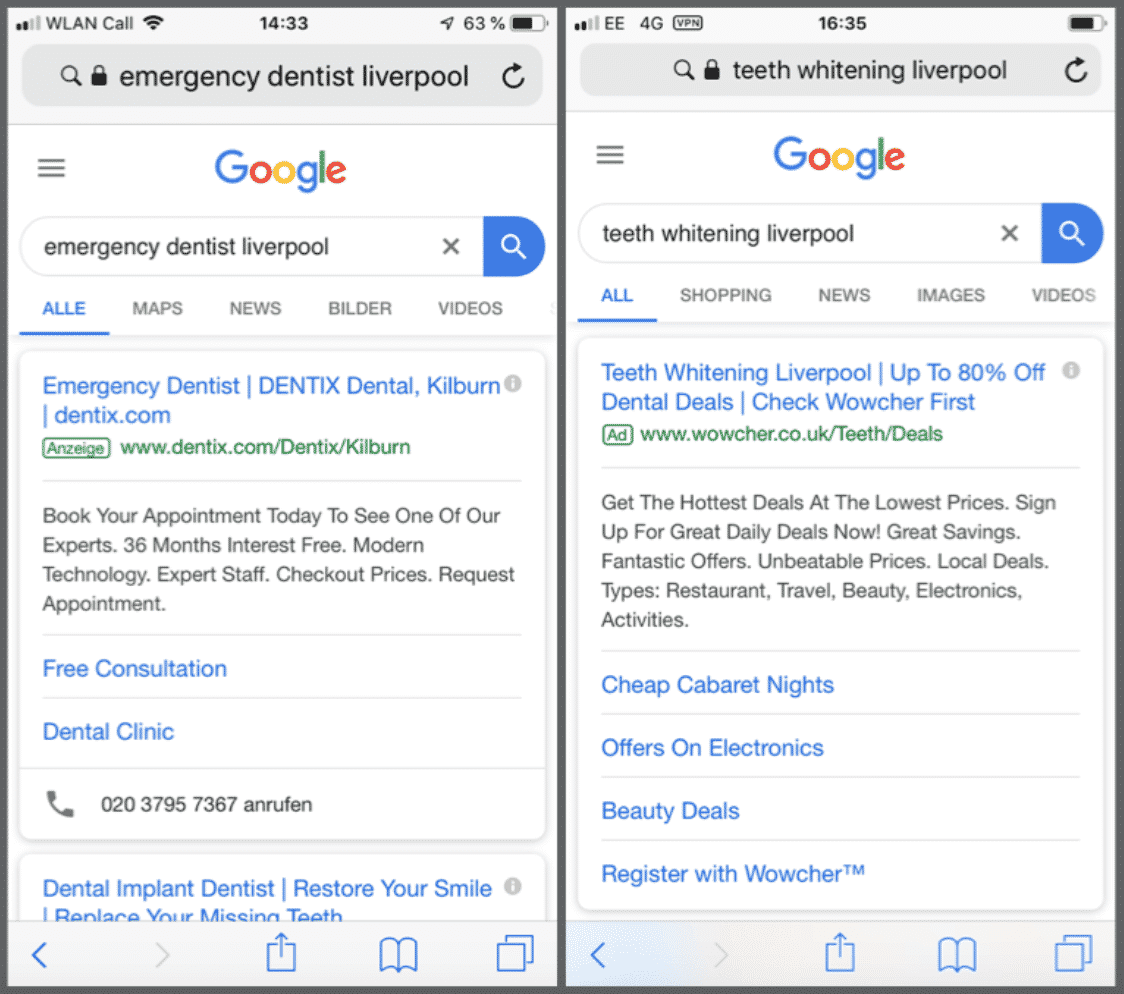
These ads suck in many ways. But most importantly, they are making the disastrous mistake (in my view) of trying too hard to get a click.
Reviews catch people’s eyes and these are what I’d focus on for branding. In addition, these ads make the mistake of saying too much. They need to be more specific and focus on just one thing. One brand promise.
Remember the first rule of advertising, it’s not about you—it’s about them.
So, these ads are not only going to be delivering low conversions and ROI but being in the top position and attempting to get as many clicks as possible (with a dozen other problems I can see) means an expensive and wasteful campaign.
The Correct Copy
When I first came up with this approach, I sat down with the team at Disruptive and we came up with a specific advertising strategy. One that works. We used ad copy utilizing reviews, extended text and site links to fill the first paint fully.
We also made some extremely bold brand statements that would not lure more clicks but instead are focussed on getting attention. On making brand promises.
This serves to gain the trust and permission from the huge amount of impressions available to us.
With this more branding appropriate copy we utilized the position one to gain attention and make users see but not necessarily click, thus decreasing the budget—as impressions are technically free.
Again I know what you’re thinking…what about quality score?
Well, quality score is about more than just CTR—and I’ll be honest there is some magic going on behind the scenes to keep these ads optimized in position one with high quality scores without blowing through my entire budget in a morning. But you’d have to speak to Disruptive about that…
Conclusion
In the end, this new approach to paid search marketing produces extremely high CTRs in a time when advertisers are complaining about mobile ROI and moving back to desktop with their budgets.
As a result, we’ve seen between £30-40k in added revenue with astronomical margins and our organic positions have increased across many high-value keywords and positions.
It’s not a cheap methodology by any means, but it’s not expensive either when you consider the net profit gains. But again, this is a matter between you and your accountant—not you and your marketing agency.
The extra margin allows us the flexibility to hire the best people, do cool things with advertising (like predatory strategies that increase our market share) and also spend money on new technology and more importantly on our people.
So if you want a dental practice like this—then try this strategy for yourself and see where it takes you.
What do you think of this approach? Have any questions? Leave your thoughts in the comments below.





